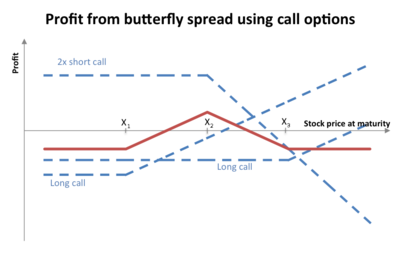This is an old revision of this page, as edited by Mglukhov (talk | contribs) at 13:52, 24 May 2015 (Added link to Butterfly strategy chart). The present address (URL) is a permanent link to this revision, which may differ significantly from the current revision.
Revision as of 13:52, 24 May 2015 by Mglukhov (talk | contribs) (Added link to Butterfly strategy chart)(diff) ← Previous revision | Latest revision (diff) | Newer revision → (diff)

In finance, a butterfly is a limited risk, non-directional options strategy that is designed to have a large probability of earning a limited profit when the future volatility of the underlying asset is expected to be lower than the implied volatility.
Long butterfly
A long butterfly position will make profit if the future volatility is lower than the implied volatility.
A long butterfly options strategy consists of the following options:
- Long 1 call with a strike price of (X − a)
- Short 2 calls with a strike price of X
- Long 1 call with a strike price of (X + a)
where X = the spot price (i.e. current market price of underlying) and a > 0.
Using put–call parity a long butterfly can also be created as follows:
- Long 1 put with a strike price of (X + a)
- Short 2 puts with a strike price of X
- Long 1 put with a strike price of (X − a)
where X = the spot price and a > 0.
All the options have the same expiration date.
At expiration the value (but not the profit) of the butterfly will be:
- zero if the price of the underlying is below (X − a) or above (X + a)
- positive if the price of the underlying is between (X - a) and (X + a)
The maximum value occurs at X (see diagram).
Short butterfly
A short butterfly position will make profit if the future volatility is higher than the implied volatility.
A short butterfly options strategy consists of the same options as a long butterfly. However now the middle strike option position is a long position and the upper and lower strike option positions are short.
Margin Requirements
Margin requirements for all options positions, including a butterfly, are governed by what is known as Regulation T. However brokers are permitted to apply more stringent margin requirements than the regulations.
Butterfly Variations
- The double option position in the middle is called the body, while the two other positions are called the wings.
- The option strategy where the middle options (the body) have different strike prices is known as a Condor.
- In case the distance between middle strike price and strikes above and below is unequal, such position is referred to as "broken wings" butterfly.
References
- McMillan, Lawrence G. (2002). Options as a Strategic Investment (4th ed. ed.). New York : New York Institute of Finance. ISBN 0-7352-0197-8.
{{cite book}}:|edition=has extra text (help) - Credit By Brokers And Dealers (Regulation T), FINRA, 1986
External links
- Long Butterfly chart on OptionCreator.com (free online Options Strategy Builder tool)